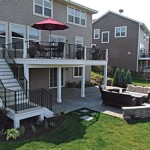Average Cost of Flagstone Patio Installation
Flagstone patios offer a natural, aesthetically pleasing, and durable outdoor living space. As a popular choice for homeowners seeking to enhance their property's value and enjoyment, understanding the costs associated with flagstone patio installation is crucial for effective budgeting and project planning. This article delves into the various factors influencing the average cost of flagstone patio installation, providing a comprehensive overview of the expenses involved.
Several elements contribute to the overall expenses. These include the type of flagstone used, the size and complexity of the patio design, site preparation requirements, labor costs, geographic location, and any additional features incorporated into the project. A thorough understanding of these components will enable homeowners to make informed decisions and accurately estimate the financial investment required for their desired flagstone patio.
Key Factor 1: Type and Cost of Flagstone
The type of flagstone selected significantly impacts the overall cost of the patio installation. Flagstone, a natural sedimentary rock, is available in various materials, colors, textures, and thicknesses. Each type possesses unique characteristics and price points, which directly affect the project's budget.
Common flagstone materials include sandstone, limestone, quartzite, and slate. Sandstone is a relatively affordable option, known for its porous nature and earthy tones. Limestone offers a smoother texture and is often found in lighter colors. Quartzite is a harder, more durable stone with a shimmering appearance, making it a more expensive choice. Slate is recognized for its dark, fine-grained appearance and is also a premium material due to its durability and unique aesthetic.
The cost of flagstone is typically measured per square foot or ton, and prices can vary widely depending on the material's rarity, quality, and transportation costs. For instance, locally sourced sandstone may be significantly less expensive than imported slate or quartzite. Furthermore, thicker flagstone slabs generally cost more than thinner ones due to the increased material and processing required. Homeowners should carefully consider the aesthetic appeal, durability, and cost-effectiveness of different flagstone types to align with their budget and desired patio design.
Beyond the base material cost, the way flagstone is processed affects price. Irregularly shaped flagstone, often sold as "random" or "natural" flagstone, is generally less expensive than precisely cut, rectangular or square pieces. While random flagstone creates a more rustic and organic look, it requires more labor to install as each piece needs custom fitting. Conversely, pre-cut flagstone simplifies installation but comes at a higher material cost.
The chosen stone's color variation also influences price. Flagstone with uniform color and texture tends to be more expensive than flagstone with significant variations. This is because achieving uniformity requires more selective quarrying and processing.
Key Factor 2: Patio Size, Design Complexity, and Site Preparation
The size of the patio directly correlates with the amount of flagstone required, which proportionally affects the total cost. A larger patio will obviously necessitate more materials and labor, leading to a higher overall expense. The design's complexity also plays a crucial role. A simple, rectangular patio is generally more cost-effective than a patio with intricate curves, multiple levels, or custom features.
Intricate designs necessitate more precise cutting and fitting of the flagstone, increasing the labor hours required. Curves and unusual shapes require specialized tools and techniques, further adding to the installation cost. Multi-level patios require additional excavation, retaining walls, and drainage solutions, all of which contribute to a higher project budget.
Site preparation is a critical aspect of flagstone patio installation and can significantly impact the overall cost. The existing ground must be properly leveled, compacted, and prepared to provide a stable base for the flagstone. This may involve removing existing vegetation, topsoil, and debris. If the site is uneven or has drainage issues, additional excavation and grading may be necessary to ensure proper water runoff and prevent future structural problems.
In some cases, the existing soil may be unsuitable for supporting a flagstone patio. This may necessitate the import and compaction of gravel or other base materials to create a solid foundation. These additional materials and labor contribute to the overall cost of site preparation. Furthermore, if the site is difficult to access, such as a backyard with limited access for machinery, the labor costs may increase due to the manual effort required to transport materials.
The presence of underground utilities, such as water pipes, gas lines, or electrical cables, can also complicate site preparation and increase costs. Identifying and working around these utilities requires careful planning and specialized equipment to avoid damage and ensure safety. Relocating utilities, if necessary, can add significant expense to the project.
Key Factor 3: Labor Costs and Geographic Location
Labor costs constitute a significant portion of the total flagstone patio installation expense. The rates charged by contractors vary depending on their experience, expertise, and the prevailing labor rates in the geographic area. Highly skilled and experienced installers typically command higher rates, but their expertise can ensure a higher quality installation and minimize potential problems in the long run.
The complexity of the patio design and the specific installation techniques employed also influence labor costs. Installing flagstone in a mortar bed, where each stone is individually mortared in place, generally requires more labor than dry-laying flagstone on a bed of sand or gravel. Mortar installation offers greater stability and longevity but comes at a higher labor cost.
Geographic location significantly impacts labor costs due to variations in the cost of living, prevailing wage rates, and local regulations. Labor rates in urban areas and regions with a high cost of living are generally higher than in rural areas or regions with a lower cost of living. Additionally, some regions may have stricter licensing requirements and building codes, which can affect the availability of qualified contractors and potentially increase labor costs.
The time of year can also influence labor costs. Demand for outdoor landscaping services tends to be higher during the spring and summer months, which may lead to increased labor rates. Scheduling the installation during the off-season, such as fall or winter, may potentially result in lower labor costs, although weather conditions may affect the project's timeline and feasibility.
It is important to obtain multiple quotes from different contractors to compare their pricing and services. When evaluating quotes, consider not only the hourly rate but also the contractor's experience, reputation, and warranty offerings. A lower hourly rate may not always be the best value if the contractor lacks the necessary expertise or uses inferior materials. Thoroughly research and vet potential contractors to ensure a high-quality installation at a fair price.
The choice between hiring a general contractor or a specialized landscape contractor directly impacts the labor costs. A general contractor typically manages all aspects of the project, including hiring subcontractors for specific tasks like flagstone installation. While this approach offers convenience, it may also increase the overall cost due to the general contractor's management fees. Hiring a specialized landscape contractor directly can potentially reduce costs, but it requires more effort on the homeowner's part to coordinate different aspects of the project.
Beyond the core installation, consider additional labor for features like steps, seat walls, or fire pits. These enhancements require specialized skills and increase the project's overall labor expense. For example, building a seat wall involves constructing a stable foundation, laying flagstone, and ensuring proper drainage, all requiring significant labor hours.
Finally, ongoing maintenance can incur labor costs. While flagstone is durable, periodic cleaning, sealing, and joint repairs may be necessary to maintain its appearance and structural integrity. Planning for these future maintenance costs helps ensure the patio remains in optimal condition for years to come. These costs, although not part of the initial installation, should be factored into the overall long-term expense of owning a flagstone patio.

Average Flagstone Patio S In 2024 Forbes Home

How Much Does Flagstone Cost Landscaping Network

How Much Does A Flagstone Patio Cost 2024 Data

How Much Does Flagstone Cost 2024 Data

How Much Does A Patio Cost Installation 2024 Landscaping Network

How Much Does Flagstone Cost 2024 Data

Is Flagstone Er Than Pavers And What Are Its Pros Cons

How Much Does A Flagstone Patio Cost 2024 S

5 Things You Need To Know About A Flagstone Patio Land Designs By Colton

How Much Does A Stone Patio Cost 2024 S
Related Posts








